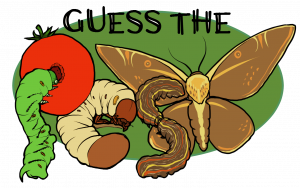
Bill Cissel, Extension Agent – Integrated Pest Management, University of Delaware; bcissel@udel.edu
Congratulations Jeffrey O’Hara for correctly identifying the damage in the photo as spider mite damage and for being selected to be entered into the end of season raffle for $100 not once but five times. Everyone else who guessed correctly will also have their name entered into the raffle. Click on the Guess the Pest logo to participate in this week’s Guess the Pest challenge!
Guess the Pest Week #16 Answer: Spider Mite

The damage in the photo is from two-spotted spider mite (TSM) feeding on soybean. Hot, dry weather favors TSM and drought can trigger outbreaks. TSM populations are held in balance by natural enemies and the weather. Under high temperatures, the amount of time required for TSM to complete its lifecycle is shortened, allowing more generations to be completed in a shorter period of time. A female TSM can produce 300 offspring in her lifetime (~30 days) and most of the individuals in the population are female. Dry conditions also diminish the activity of fungal diseases that often play a key role in keeping outbreaks from occurring.
So, if it rains, does it mean we don’t need to worry about TSM? Precipitation not only favors spore formation and mite infection but also reduces plant stress. This however isn’t always a silver bullet and TSM populations can continue to increase even after rain events, especially if the weather returns to being hot and dry. Cool nights and humid conditions promote the fungal disease that infects TSM.
Below is a graph showing rain events and observed TSM populations in the untreated check from a TSM field trial conducted in Georgetown, DE in 2017:
Observed Influence of Precipitation on Two-Spotted Spider Mite Populations, 2017

Weather data obtained from the Delaware Environmental Observing System (DEOS): http://www.deos.udel.edu/data/agirrigation_retrieval.php
As you can see in the graph, TSM populations continued to increase and remained high despite rain events occurring on 7/22, 7/23, 7/25, and 7/28.
To scout for TSM, examine the underside of 5 leaflets in 10 locations for mites, noting the presence of mite eggs and the amount of leaf damage. The threshold for TSM during bloom to podfill is 20-30 mites per leaflet and 10% of plants with 1/3 or more leaf area damaged.
Concentrate scouting efforts on field edges for initial detection, especially edges bordered by grass and road ditches (it’s not unusual to also find hot spots in the interior portions of the field). TSM typically develop on grasses and other plants on field borders before ballooning into fields. Once TSM are detected, scout the interior portions of the field to determine if they have spread throughout the entire field. If only concentrated on field edges, spot treating may be an option. If spot treating on field edges, extend the treated area about 100 feet further into the field from the damaged area.
Here is a link to our Soybean Insecticide Recommendations for chemical control options if your field is at threshold for TSM: https://cdn.extension.udel.edu/wp-content/uploads/2018/05/02102500/Insect-Control-in-Soybeans-2018.pdf








